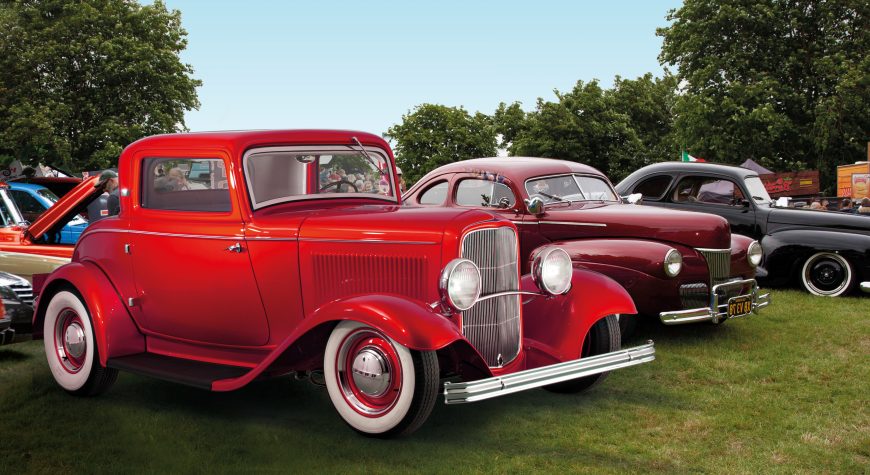A
Auto Express
Guest
It’s now well over 30 years since the iconic Ford Capri went out of production – but over that period, the badge has remained a popular one with enthusiasts. Indeed, the idea of a reborn version of the people’s sports car has been alluded to more than once by Ford executives, prompting countless scoops on the subject by the motoring media, Auto Express included.
But how close has a reborn Capri ever actually been to making production? How much has Ford played around with its parts bin, platform line-up and marketing strategy to see if a ‘new Capri’ might be feasible?
The answers to these questions may well lie in a new book from motor industry insider Steve Saxty. A veteran of Ford’s own product design team who has also had stints at Mazda, Jaguar and Porsche, Saxty has spent much of the past five years speaking to former Ford employees about projects that never saw the light of day – and following this up by extracting hundreds of previously unseen photos from the depths of the company’s image archives.
The resulting book, Secret Fords, stretches across two volumes, and reveals how Ford experimented constantly with projects that never saw the light of day – everything from a luxury saloon to a Ferrari-chasing supercar and a four-wheel-drive Focus Cosworth.
The books also include no fewer than eight previously unseen Capri projects – a tally that came as a surprise to Saxty himself, not least because he’s previously written a book about that model. “I thought I really had covered off the Capri,” Saxty told us. “But then as people started opening up for Secret Fords, they kept thinking of cars they’d seen in the studio, sometimes 40 years ago. And that sent me back into the archives, hunting for these cars – and I was amazed at what turned up.”
In this exclusive picture selection from the book, we’re showcasing just a handful of the Capri concepts – one that previewed the third generation of the car, and three more that demonstrate how Ford’s design hierarchy was playing around with what the model could become.
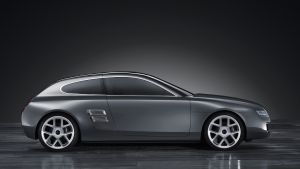
Secret Fords uncovered - Visos

Secret Fords uncovered - Visos
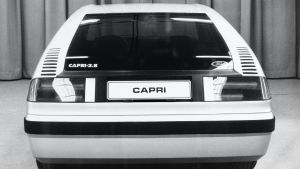
Secret Fords uncovered
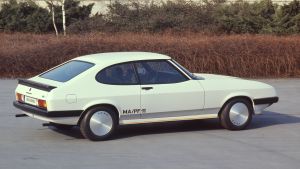
Secret Fords uncovered - Modular
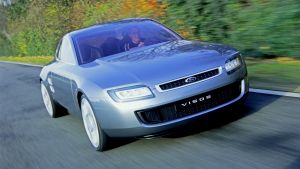
Secret Fords uncovered - Visos
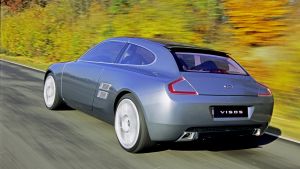
Secret Fords uncovered - Visos

Secret Fords uncovered
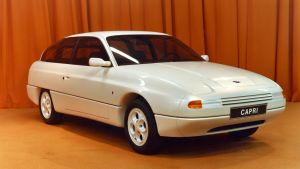
Secret Fords uncovered
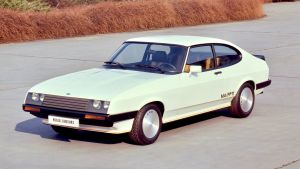
Secret Fords uncovered - Modular
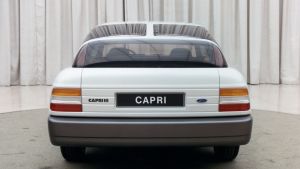
image
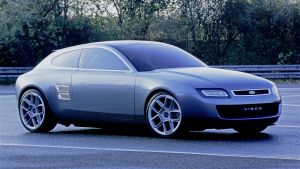
Secret Fords uncovered - Visos
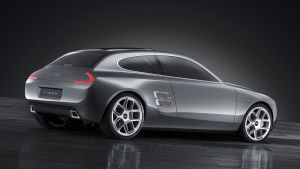
Secret Fords uncovered - Visos
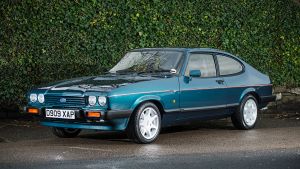
Secret Fords uncovered - Brooklands
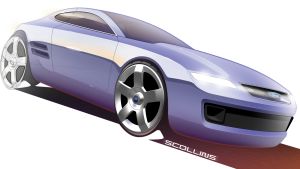
Secret Fords uncovered - Visos
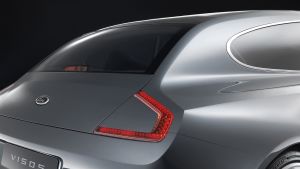
Secret Fords uncovered - Visos
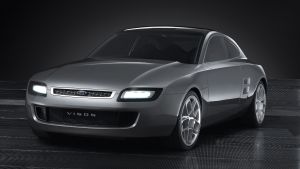
Secret Fords uncovered - Visos
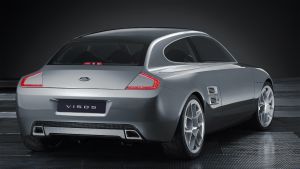
Secret Fords uncovered - Visos

Secret Fords uncovered - book
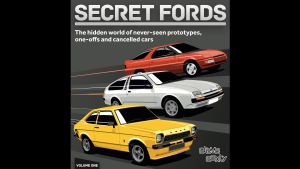
Secret Fords uncovered - book
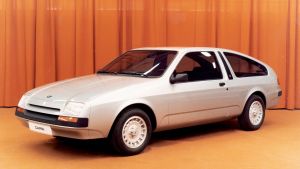
Secret Fords uncovered

Secret Fords uncovered - book
This design study was actually created in 1976, when Ford tried to spice up the fairly bland Mk2 Capri into something that would have more appeal with the original car’s customer base. It was, in fact, shown to the public at the 1976 Geneva Motor Show – but drew little attention because the press was focused on the forthcoming new Fiesta and Cortina.
MA/PF-11 was a bit of a design mash-up that took elements from the existing Mk2 Capri and grafted on cues from the Escort RS2000 – most notably that car’s vane front grille, made all the cleaner on the Capri concept by the placement of the Ford badge on the leading edge of the bonnet above.
Other show-car elements included 17-inch wheels (normal today, but giant in comparison with the Capri’s usual 13-inch items back in 1976), a rear spoiler and a moulding over the top of the A-pillar, designed to give the car a smoother overall look.
The MA/PF-11 concept you see here didn’t make it through to production unchanged, but Ford’s Swiss designer Heinz Berhalter tweaked the front grille and simplified the rear spoiler to give it a more elegant look, without the show car’s long nose.
It worked, too; the resulting Mk3 Capri, which was introduced in 1978, lasted all the way through until the final examples of the car were delivered in 1987.

Secret Fords uncovered - Visos

Secret Fords uncovered - Visos

Secret Fords uncovered

Secret Fords uncovered - Modular

Secret Fords uncovered - Visos

Secret Fords uncovered - Visos

Secret Fords uncovered

Secret Fords uncovered

Secret Fords uncovered - Modular

image

Secret Fords uncovered - Visos

Secret Fords uncovered - Visos

Secret Fords uncovered - Brooklands

Secret Fords uncovered - Visos

Secret Fords uncovered - Visos

Secret Fords uncovered - Visos

Secret Fords uncovered - Visos

Secret Fords uncovered - book

Secret Fords uncovered - book

Secret Fords uncovered

Secret Fords uncovered - book
One of four never-before-seen Ghia studies featured in Saxty’s book, this model was created in September 1980, just a few months after the Sierra had been signed off, but still almost two years before the controversial Cortina replacement would actually reach production.
The Ford-owned consultancy was given a brief to shake up the established design process by coming up with left-field alternatives to the mainstream models – and it certainly did that with this concept. The proposed Mk4 Capri took its windscreen and headlights from the Sierra, plus the doors from the three-door version of that car.
The key element in the car’s profile was the blacked-out panel on the B-pillar, because it allowed Ghia’s team to shorten the rear window a little in a bid to give the car more of a coupé look instead of remaining too much of a three-door family car. A little surfacing, low down on the flanks, helped to reduce the visual mass of the side panels, too.
With the Sierra’s rear-drive chassis beneath it, and the potential for V6 power or even four-wheel drive, this model could have been a fascinating proposition for a Mk4 Capri; the shared underpinnings could have helped Ford to keep down costs, too. But the market had already started to move towards smaller, more fuel-efficient coupés like the VW Scirocco, and hot hatches such as the VW Golf GTI – so Ghia’s efforts never made it beyond this early stage.

Secret Fords uncovered - Visos

Secret Fords uncovered - Visos

Secret Fords uncovered

Secret Fords uncovered - Modular

Secret Fords uncovered - Visos

Secret Fords uncovered - Visos

Secret Fords uncovered

Secret Fords uncovered

Secret Fords uncovered - Modular

image

Secret Fords uncovered - Visos

Secret Fords uncovered - Visos

Secret Fords uncovered - Brooklands

Secret Fords uncovered - Visos

Secret Fords uncovered - Visos

Secret Fords uncovered - Visos

Secret Fords uncovered - Visos

Secret Fords uncovered - book

Secret Fords uncovered - book

Secret Fords uncovered

Secret Fords uncovered - book
Behold the Capri Kammback, which took the Mk3 Escort XR3 as its inspiration instead of the Sierra. This radical-looking concept was Ghia’s fourth and final attempt at making a Capri, created with the following (self-provided) brief: “This proposal has a unique and distinct personality – combining the sporty image of the Capri with the functional characteristics of a station wagon [estate car]. The Capri Kammback features seating for four, with access through the tailgate or through the centre-hinged wrapover quarter window, allowing easy kerbside loading.”
The resulting vehicle is unlike anything seen in Ford’s back catalogue, with even the longer main doors dwarfed by the slab of bodywork running from B-pillar to tail, supporting a complex glass structure that would have been potentially ruinous to make. The telltale design cue on this model – apart from those XR3 alloys – is the rising beltline, which is meant to highlight the switch to front-wheel drive.
The radical Kammback looks a long way from a traditional Capri replacement – but it was considered seriously enough for it to be flown to the United States for aerodynamic testing. Indeed, the two Ghia models featured here are among the most secret design studies to feature in Saxty’s book, because the codes on the few images unearthed of them would indicate that they were shipped direct from the firm’s workshops in Turin to Dearborn in the US. So they bypassed all of Ford’s European design know-how – becoming, to some extent, secret cars within Ford itself.
Incidentally, the images reveal that this was proposed as ‘Capri III’ – a reflection of how Ford never referred to the Mk3 Capri by that designation. The company always believed that the model that ran from 1978 to 1987 was the facelifted Mk2.

Secret Fords uncovered - Visos

Secret Fords uncovered - Visos

Secret Fords uncovered

Secret Fords uncovered - Modular

Secret Fords uncovered - Visos

Secret Fords uncovered - Visos

Secret Fords uncovered

Secret Fords uncovered

Secret Fords uncovered - Modular

image

Secret Fords uncovered - Visos

Secret Fords uncovered - Visos

Secret Fords uncovered - Brooklands

Secret Fords uncovered - Visos

Secret Fords uncovered - Visos

Secret Fords uncovered - Visos

Secret Fords uncovered - Visos

Secret Fords uncovered - book

Secret Fords uncovered - book

Secret Fords uncovered

Secret Fords uncovered - book
As things stand, this car is where the Capri story ends – because Project S272 marked the last serious attempt to bring the nameplate back to life. The car’s existence was inextricably linked to Martin Leach, who became Ford of Europe’s president in 2002. The British exec had seen ‘retro-modern’ cars like the reborn MINI and Beetle, BMW’s Z8 and Ford’s own Thunderbird, and he decided that the time was right for the Capri name to return.
Ford’s designers, led by J Mays and Chris Bird, approved a concept created by Chris Svensson (father of the original Puma and first Ka). Called Visos, it assumed that customers wouldn’t want a pastiche of an old Capri, but rather a more sophisticated, forward-looking sports coupé.
As such, the concept was clearly based on a relatively small platform – in this case, the Focus’s – although thanks to the three-door bodystyle, it was easier to draw similarities
with the Volvo C30, which also used the same architecture. However, Ford claimed a more ambitious powertrain than those cars’, proposing a twin-turbo six-cylinder engine producing 350bhp, and four-wheel drive.
The design had a neat front end that subtly referenced the Capri’s multi-headlight arrangement, and also incorporated an upturned hockey-stick side swage, dummy air vents just ahead of the rear wheels, and unusually muscular rear shoulders for such a small model.
The Visos was in fact displayed at the 2003 Frankfurt Motor Show, where Ford insiders did their best to hint to media that the car could be the “new Capri”. The firm even trotted the concept (freshly repainted in metallic green)
out for test drives by the motoring press, including Auto Express, which concluded that the car had solid potential
to be a halo model for the rest of the Ford range.
Plans for a production version took a hit, though, when research showed that while potential buyers liked the Audi-esque sophistication, they wiped £10,000 off their expected price when they realised it was a Ford.
In the end, Leach left Ford just as the Visos concept was being released. As a result, Project S272 lost momentum at a crucial stage, and any hope of the Capri name returning died with it. For the time being, at least.
Find out how some radical concept cars were able to enter production...
Continue reading...
But how close has a reborn Capri ever actually been to making production? How much has Ford played around with its parts bin, platform line-up and marketing strategy to see if a ‘new Capri’ might be feasible?
The answers to these questions may well lie in a new book from motor industry insider Steve Saxty. A veteran of Ford’s own product design team who has also had stints at Mazda, Jaguar and Porsche, Saxty has spent much of the past five years speaking to former Ford employees about projects that never saw the light of day – and following this up by extracting hundreds of previously unseen photos from the depths of the company’s image archives.
The resulting book, Secret Fords, stretches across two volumes, and reveals how Ford experimented constantly with projects that never saw the light of day – everything from a luxury saloon to a Ferrari-chasing supercar and a four-wheel-drive Focus Cosworth.
The books also include no fewer than eight previously unseen Capri projects – a tally that came as a surprise to Saxty himself, not least because he’s previously written a book about that model. “I thought I really had covered off the Capri,” Saxty told us. “But then as people started opening up for Secret Fords, they kept thinking of cars they’d seen in the studio, sometimes 40 years ago. And that sent me back into the archives, hunting for these cars – and I was amazed at what turned up.”
In this exclusive picture selection from the book, we’re showcasing just a handful of the Capri concepts – one that previewed the third generation of the car, and three more that demonstrate how Ford’s design hierarchy was playing around with what the model could become.
MA/PF-11 Modular Capri

Secret Fords uncovered - Visos

Secret Fords uncovered - Visos

Secret Fords uncovered

Secret Fords uncovered - Modular

Secret Fords uncovered - Visos

Secret Fords uncovered - Visos

Secret Fords uncovered

Secret Fords uncovered

Secret Fords uncovered - Modular

image

Secret Fords uncovered - Visos

Secret Fords uncovered - Visos

Secret Fords uncovered - Brooklands

Secret Fords uncovered - Visos

Secret Fords uncovered - Visos

Secret Fords uncovered - Visos

Secret Fords uncovered - Visos

Secret Fords uncovered - book

Secret Fords uncovered - book

Secret Fords uncovered

Secret Fords uncovered - book
This design study was actually created in 1976, when Ford tried to spice up the fairly bland Mk2 Capri into something that would have more appeal with the original car’s customer base. It was, in fact, shown to the public at the 1976 Geneva Motor Show – but drew little attention because the press was focused on the forthcoming new Fiesta and Cortina.
MA/PF-11 was a bit of a design mash-up that took elements from the existing Mk2 Capri and grafted on cues from the Escort RS2000 – most notably that car’s vane front grille, made all the cleaner on the Capri concept by the placement of the Ford badge on the leading edge of the bonnet above.
Other show-car elements included 17-inch wheels (normal today, but giant in comparison with the Capri’s usual 13-inch items back in 1976), a rear spoiler and a moulding over the top of the A-pillar, designed to give the car a smoother overall look.
The MA/PF-11 concept you see here didn’t make it through to production unchanged, but Ford’s Swiss designer Heinz Berhalter tweaked the front grille and simplified the rear spoiler to give it a more elegant look, without the show car’s long nose.
It worked, too; the resulting Mk3 Capri, which was introduced in 1978, lasted all the way through until the final examples of the car were delivered in 1987.
Ghia’s ‘Sierra Capri’

Secret Fords uncovered - Visos

Secret Fords uncovered - Visos

Secret Fords uncovered

Secret Fords uncovered - Modular

Secret Fords uncovered - Visos

Secret Fords uncovered - Visos

Secret Fords uncovered

Secret Fords uncovered

Secret Fords uncovered - Modular

image

Secret Fords uncovered - Visos

Secret Fords uncovered - Visos

Secret Fords uncovered - Brooklands

Secret Fords uncovered - Visos

Secret Fords uncovered - Visos

Secret Fords uncovered - Visos

Secret Fords uncovered - Visos

Secret Fords uncovered - book

Secret Fords uncovered - book

Secret Fords uncovered

Secret Fords uncovered - book
One of four never-before-seen Ghia studies featured in Saxty’s book, this model was created in September 1980, just a few months after the Sierra had been signed off, but still almost two years before the controversial Cortina replacement would actually reach production.
The Ford-owned consultancy was given a brief to shake up the established design process by coming up with left-field alternatives to the mainstream models – and it certainly did that with this concept. The proposed Mk4 Capri took its windscreen and headlights from the Sierra, plus the doors from the three-door version of that car.
The key element in the car’s profile was the blacked-out panel on the B-pillar, because it allowed Ghia’s team to shorten the rear window a little in a bid to give the car more of a coupé look instead of remaining too much of a three-door family car. A little surfacing, low down on the flanks, helped to reduce the visual mass of the side panels, too.
With the Sierra’s rear-drive chassis beneath it, and the potential for V6 power or even four-wheel drive, this model could have been a fascinating proposition for a Mk4 Capri; the shared underpinnings could have helped Ford to keep down costs, too. But the market had already started to move towards smaller, more fuel-efficient coupés like the VW Scirocco, and hot hatches such as the VW Golf GTI – so Ghia’s efforts never made it beyond this early stage.
Capri Kammback

Secret Fords uncovered - Visos

Secret Fords uncovered - Visos

Secret Fords uncovered

Secret Fords uncovered - Modular

Secret Fords uncovered - Visos

Secret Fords uncovered - Visos

Secret Fords uncovered

Secret Fords uncovered

Secret Fords uncovered - Modular

image

Secret Fords uncovered - Visos

Secret Fords uncovered - Visos

Secret Fords uncovered - Brooklands

Secret Fords uncovered - Visos

Secret Fords uncovered - Visos

Secret Fords uncovered - Visos

Secret Fords uncovered - Visos

Secret Fords uncovered - book

Secret Fords uncovered - book

Secret Fords uncovered

Secret Fords uncovered - book
Behold the Capri Kammback, which took the Mk3 Escort XR3 as its inspiration instead of the Sierra. This radical-looking concept was Ghia’s fourth and final attempt at making a Capri, created with the following (self-provided) brief: “This proposal has a unique and distinct personality – combining the sporty image of the Capri with the functional characteristics of a station wagon [estate car]. The Capri Kammback features seating for four, with access through the tailgate or through the centre-hinged wrapover quarter window, allowing easy kerbside loading.”
The resulting vehicle is unlike anything seen in Ford’s back catalogue, with even the longer main doors dwarfed by the slab of bodywork running from B-pillar to tail, supporting a complex glass structure that would have been potentially ruinous to make. The telltale design cue on this model – apart from those XR3 alloys – is the rising beltline, which is meant to highlight the switch to front-wheel drive.
The radical Kammback looks a long way from a traditional Capri replacement – but it was considered seriously enough for it to be flown to the United States for aerodynamic testing. Indeed, the two Ghia models featured here are among the most secret design studies to feature in Saxty’s book, because the codes on the few images unearthed of them would indicate that they were shipped direct from the firm’s workshops in Turin to Dearborn in the US. So they bypassed all of Ford’s European design know-how – becoming, to some extent, secret cars within Ford itself.
Incidentally, the images reveal that this was proposed as ‘Capri III’ – a reflection of how Ford never referred to the Mk3 Capri by that designation. The company always believed that the model that ran from 1978 to 1987 was the facelifted Mk2.
Project S272/Visos

Secret Fords uncovered - Visos

Secret Fords uncovered - Visos

Secret Fords uncovered

Secret Fords uncovered - Modular

Secret Fords uncovered - Visos

Secret Fords uncovered - Visos

Secret Fords uncovered

Secret Fords uncovered

Secret Fords uncovered - Modular

image

Secret Fords uncovered - Visos

Secret Fords uncovered - Visos

Secret Fords uncovered - Brooklands

Secret Fords uncovered - Visos

Secret Fords uncovered - Visos

Secret Fords uncovered - Visos

Secret Fords uncovered - Visos

Secret Fords uncovered - book

Secret Fords uncovered - book

Secret Fords uncovered

Secret Fords uncovered - book
As things stand, this car is where the Capri story ends – because Project S272 marked the last serious attempt to bring the nameplate back to life. The car’s existence was inextricably linked to Martin Leach, who became Ford of Europe’s president in 2002. The British exec had seen ‘retro-modern’ cars like the reborn MINI and Beetle, BMW’s Z8 and Ford’s own Thunderbird, and he decided that the time was right for the Capri name to return.
Ford’s designers, led by J Mays and Chris Bird, approved a concept created by Chris Svensson (father of the original Puma and first Ka). Called Visos, it assumed that customers wouldn’t want a pastiche of an old Capri, but rather a more sophisticated, forward-looking sports coupé.
As such, the concept was clearly based on a relatively small platform – in this case, the Focus’s – although thanks to the three-door bodystyle, it was easier to draw similarities
with the Volvo C30, which also used the same architecture. However, Ford claimed a more ambitious powertrain than those cars’, proposing a twin-turbo six-cylinder engine producing 350bhp, and four-wheel drive.
The design had a neat front end that subtly referenced the Capri’s multi-headlight arrangement, and also incorporated an upturned hockey-stick side swage, dummy air vents just ahead of the rear wheels, and unusually muscular rear shoulders for such a small model.
The Visos was in fact displayed at the 2003 Frankfurt Motor Show, where Ford insiders did their best to hint to media that the car could be the “new Capri”. The firm even trotted the concept (freshly repainted in metallic green)
out for test drives by the motoring press, including Auto Express, which concluded that the car had solid potential
to be a halo model for the rest of the Ford range.
Plans for a production version took a hit, though, when research showed that while potential buyers liked the Audi-esque sophistication, they wiped £10,000 off their expected price when they realised it was a Ford.
In the end, Leach left Ford just as the Visos concept was being released. As a result, Project S272 lost momentum at a crucial stage, and any hope of the Capri name returning died with it. For the time being, at least.
Find out how some radical concept cars were able to enter production...
Continue reading...

